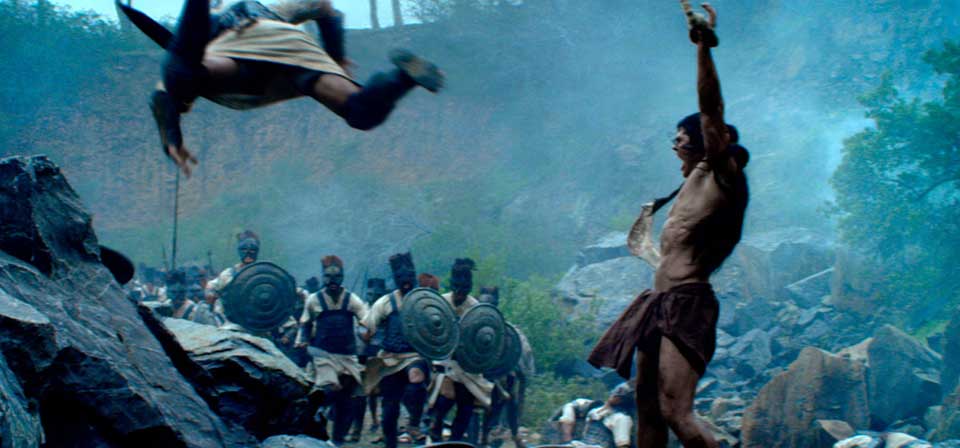Search Results
219 records found
Sabrina (1954)
The prologue, with its storybook-like, slightly arch voiceover narration finely read by Audrey Hepburn, suggests a charming fairy tale with a satiric subtext. And, indeed, Sabrina, Billy Wilder’s delightful romantic comedy starring Hepburn, Humphrey Bogart, and William Holden, is a sort of Cinderella story, with a chauffeur’s daughter who is transformed into the belle of the ball and dances with the prince — except that the "prince" is, if not a beast, at least a shallow cad, while the real love interest is almost more a frog than a prince.

The sacred and the profane: Religious themes in vampire fiction
Almost from the beginning, vampire fiction has been a battleground between the powers of heaven and hell.
The Sacrifice (1986)
To “rip open the inconsolable secret,” to awaken the spiritual hunger for something beyond the materialistic scope of our fragmented, desacrilized modern existence, was the burden of Andrei Tarkovsky, cinematic poet laureate of the Russian soul.
Sahara (1943)
One of the best WWII-era WWII movies, Sahara is a thoroughly entertaining war actioner starring Humphrey Bogart as a tough American sergeant commanding a tank crew in the Libyan desert.
Salt (2010)
Salt is tasty in moderation, though you wouldn’t want to make it a big part of your diet.
The Salton Sea (2002)
This is not a thought Tom takes to heart. Nor is it one he struggles with, or indeed ever thinks about again. The quest for revenge is at the heart of The Salton Sea, and although in this one scene the film fleetingly acknowledges the possibility of an alternative to bitterness and hatred, it’s not in the context of any larger interest in or exploration of the moral issues.

Samson (2018)
If you ever wondered what it might have looked like for Samson to slay 1,000 Philistines with the jawbone of an ass, wonder no more.
San Andreas [video]
The Rock versus massive earthquake event. Seems fair.
Sanctum (2011)
The shocking thing about Sanctum’s fictional survival story, relocated to Papua New Guinea, is not that it kills off one expedition member after another, often quite brutally. The shocking thing is how callously it treats their lives. More than one team member is euthanized by his fellows, submerged and drowned after sustaining catastrophic injuries.
The Santa Clause 2 (2002)
Like those MasterCard ads that, while admitting that “there are some things that money can’t buy,” still manage to suggest that even these things are somehow among the many benefits of using MasterCard, The Santa Clause 2 is strangely reticent about the idea that Christmas is ultimately about anything other than presents from the red-suited guy.
Sarandon calls pope “Nazi”; ADL calls for apology
Memo to Susan Sarandon, vis-a-vis your “Nazi pope” comments this weekend: Joseph Ratzinger was a victim of the Nazi horror.

Saving Mr. Banks (2013)
Tom Hanks as Walt Disney. That’s almost enough to sell the picture by itself, isn’t it? Who but Hanks can one imagine in the role?
Saving Private Ryan (1998)
Steven Spielberg’s harrowing WWII drama opens with a horrifying recreation of the D-Day invasion of Normandy Beach that has been called the most realistic war sequence ever shot.
Saving the Titanic on PBS
Saving the Titanic, a docudrama airing this month on PBS, sheds light on an untold page from the heroic side of the ledger. Combining traditional documentary with speculative historical dramatization, it highlights the story of the engineering crew, firemen, electricians and stokers who labored below decks to keep power flowing to pumps and lifeboat winches, first hoping to save the ship and then striving to delay the inevitable as long as possible to save as many lives as possible.
Say Amen, Somebody (1982)
If the toe-tapping gospel music of The Fighting Temptations appeals to you but you were put off by that film’s negative Christian stereotypes and lack of even rote Hollywood spiritual uplift or pro-faith sentiment, treat yourself to this engaging, gospel-infused documentary tribute to the African-American men and women who first began combining the heart and soul of Negro spirituals with the infectious rhythms of jazz and blues.
The Scarlet and the Black (1983)
Riveting and edifying, this WWII drama stars Gregory Peck as Msgr. Hugh O’Flaherty, a plain-speaking, straight-dealing Irish priest who boldly aids enemies of the Third Reich under the watchful eye of Christopher Plummer’s Nazi Lt. Col. Herbert Kappler. Their cat-and-mouse game is thrilling and great fun, and culminates in a startling showdown in a very significant setting.

Schindler’s List (1993)
From the armbands to the ghettos, from forced labor to extermination camps and beyond, Schindler’s List covers the successive historical stages of the Final Solution more comprehensively than any other popular film had at the time, or has since. That, in part, is its great achievement — and, for many of its critics, its enduring stigma.
The School of Rock vs. The Fighting Temptations
The hero’s nearly religious reverence for rock’s angry posturing and anti-authoritarianism — reverence culminating in a pre-concert prayer to the "God of rock" — isn’t quite condoned, but isn’t put in any larger context either. Rock culture’s darker side is whitewashed (it’s not about drugs, kids, and groupies are really just band cheerleaders!), and subjects other than music (and even music other than rock) get short shrift. Then there’s the swishing, lisping fifth-grade "band stylist" bringing "Queer Eye" camp to the grade-school setting.

Science fiction and transcendence: 2001: A Space Odyssey and the elusiveness of awe
Released 55 years ago, Stanley Kubrick’s iconic masterpiece — honored on the 1995 Vatican film list — has often been likened to “a religious experience.” Why do some of its successors capture this better than others?
Scooby-Doo (2002)
Scooby Dooby Doo
And Shaggy too
You both look and sound great.
But Daphne, you’re too Buff
Fred thinks he’s tough
And Velma — wow, you’ve lost weight!
Recent
Home Video
Copyright © 2000– Steven D. Greydanus. All rights reserved.